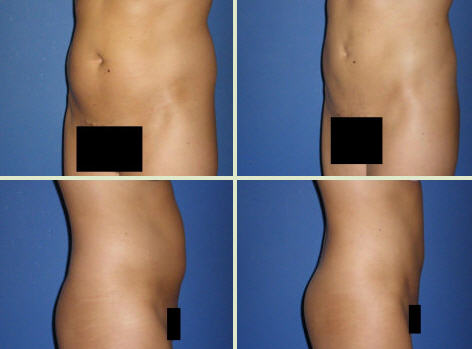
Liposuction in Lansing Michigan
General Information about Liposuction
Information on liposuction in Lansing Michigan. Procedure details, tumescent liposuction techniques, suction-assisted lipo, super-wet lipo, truths and facts, body sculpting and more.
Background
Liposuction was first performed in France (after 1970) and quickly "spread" to the United States. General anesthesia was always used, no fluid was placed under the skin, and large cannulas (tubes) were used to remove the excess fat. Plastic surgeons performed almost all of the operations. Although the procedure showed much promise, serious complications were not uncommon. Large amounts of blood loss, fluid overload, and anesthetic complications were (and are) relatively common.
In 1987, Jeffrey A Klein, M.D. (a dermatologist) introduced the "tumescent liposuction technique." This technique infuses large amounts of fluid with very dilute local anesthetic solution under the skin, using much smaller cannulas. Fundamental to his method of liposuction was the avoidance of any systemic anesthesia (either IV sedation or general anesthesia). The total amounts of local anesthetic used were revolutionary, higher than the previous levels thought "safe" by the FDA.
A much safer, gentler liposuction resulted, which, when done correctly, usually causes less blood loss than the amount removed during a blood test (less than 10 cc). Patients are awake, and usually are able to walk out of surgery alert. The cosmetic results are equal to, or better than those of the "old" methods, with complication rates that are at least 500 to 800 times less. Patients recover much faster, and usually prefer this technique to other liposuction methods, once they have experienced it.
True tumescent liposuction with only local anesthesia depends upon very strict drug protocols, careful technique, no systemic anesthesia, and no IV fluids during surgery. Many surgeons dislike this type of surgery for several reasons, not the least of which are the extra care required, and an awake patient. Many "plastic surgeons" (accustomed to a sleeping patient with general anesthesia) have been unwilling and/or unable to completely follow Dr. Klein's protocol. Surgeons who are very comfortable doing surgery using "awake" local anesthesia (dermatologists, ophthalmologists, and ear, nose and throat specialists, to name a few) adapt relatively quickly to the technique.
"Variations" of the tumescent technique have evolved, including a "super wet" version where huge amounts of fluid are placed under the skin, and anesthesia given intravenously (IV). At present, many surgeons use the "tumescent" portion of the technique (large amounts of fluid under the skin) but continue to give systemic anesthesia (general anesthesia or IV sedation) and IV fluids, while using large cannulas. This is not the "true" tumescent anesthesia as it is described by Klein, and is not as safe. Because many liposuction procedures currently performed are not performed using "true local anesthesia," many serious, avoidable complications continue to occur, and have been heavily reported in the media. Although it is now the most commonly performed cosmetic surgical procedure, liposuction continues to create significant "bad press" and "horror stories" that include (in some studies) a death rate of 1 per 1000 surgeries.
In June of 2000, I studied with Dr. Klein, to learn "from the horse's mouth" the technique of tumescent, microcannula liposuction using only local anesthesia. My goal is to deliver the safest, most effective, most comfortable, and most advanced liposuction possible, so that Trillium patients can achieve the best possible results, while returning to their normal activities in the minimal amount of time. As with everything we do at Trillium, I will offer only those services that I would recommend to my own family members. If anyone I know were thinking of liposuction, this is the technique I would strongly advise him or her to have.

View More Liposuction Before and After Photos
Liposuction Myths vs. Liposuction Facts: Don't believe everything that you hear, read, or see on TV
- I can't have liposuction until I reach my ideal weight. (After intensive diet and exercise) Nonsense. The best candidates for liposuction have a stable weight within 25 - 30 pounds of their "ideal" weight, after moderate diet and exercise. In fact, patients who are at or below their "ideal" weight may not be "good candidates" for liposuction, unless they have fatty deposits that are obviously "out of proportion" to the rest of their body.
- If people would just exercise enough and follow the right diet(s), everybody could have the shape she (he) wants, and there would be no need for liposuction. This is the most common, destructive myth of all, and completely untrue. Particularly for women, who are told (often by men and uniformly by society and the media) that if they would only "work harder, exercise more, and eat better (and less)," their problem areas of fat deposit would magically melt away. Worse yet, they feel guilty, that they somehow cannot be a "good enough" or "strong enough" person to reshape their bodies without surgery. All of us (especially after the age of 30) have body fat deposits which will not go away, even if we run 65 miles per week and eat only tofu. You simply cannot exercise or diet them away. These areas are the perfect indication for liposuction. As a very well known fashion photographer once said in a lecture I attended in Southern California: "The last thing that almost all 18-25 year old bathing suit models (including Victoria Secret's) do before a photo shoot is to cover their liposuction scars."
- Most women really need a tummy tuck. Absolutely not. The truth is, in fact, just the opposite. The vast majority of women do not "need" a tummy tuck, or the usually disfiguring scar associated with it. A "no scalpel tummy tuck" using liposuction alone gives a superior result in most cases, unless large amounts of extra skin are involved, or the underlying muscle needs tightening. At least 9 out of 10 women whom I see for a consult do not need a tummy tuck to achieve their goals.
- Liposuction is only for the tummy. Not so. Liposuction cause significant improvement in fatty deposits of the hips, legs, upper arms, "love handles," chin, neck (waddle or "gobbler" area), lower cheeks, back, "bra strap bulges," buttocks, "dowager hump" in center of upper back, and inner and outer thighs.
- I have to "go to sleep" in the hospital for liposuction. Not at all. Tumescent liposuction using local anesthesia allows you to be awake and drink fluids during the procedure. Most patients are encouraged to walk out of the office suite or ambulatory surgical room after surgery, and are on their way home within 30 minutes after surgery.
- Liposuction is so dangerous; I don't want to risk it. It doesn't need to be dangerous. This depends totally upon how the liposuction is done, and by whom. "True" tumescent liposuction with only local anesthesia is one of the safest of all surgeries performed in outpatient and office surgical suites. The risks and complications are 500-800 times less when liposuction is done in this way. With true tumescent liposuction using local anesthesia only, very few, if any, of the serious liposuction complications have been reported.
- I can't miss 2 - 6 weeks of work or normal activity. You don't have to. After tumescent liposuction with local anesthesia, most patients return to work and moderate physical activity within 2-4 days. In fact, many patients find that a 2 mile walk the day after surgery and every day for the first week after surgery helps to reduce the swelling.
- Liposuction won't last. It is a temporary "fix" for fatty areas. This is not true. The changes should be permanent. The fat cells removed cannot "grow back." With a reasonable (not necessarily weight loss) diet and moderate exercise, the treated areas should maintain their changes forever. In fact, if you do gain more weight, the fatty tissue cannot "preferentially" gather at the area that was treated. Those fat cells are gone. If you do gain some weight, the extra will not go to the treated area.
- Liposuction causes so much blood loss. I don't want that. With this liposuction technique, the total amount of blood usually lost is equal to (or less than) the amount taken for a blood test. (less than 10 cc)
- I've heard of patients who "blew up like a balloon" after liposuction, and had medical problems. Although complications are always possible, most are due to IV fluids given with systemic anesthesia, often during long surgeries. (6 - 8 hours) With our technique, you are given no IV fluids, and have no systemic sedation. Actual surgery is limited to a maximum of 2-2.5 hours, and may be only 1 - 2 hours. There is localized swelling in the treated area, but you should not have significant "water weight" after 48 hours.
- My friend had liposuction, and it was very painful after the surgery. With this technique, the local anesthetic remains active for 12-16 hours. After that, 95% of patients are comfortable with Tylenol every 4 - 6 hours, and do not require prescription pain medicines.
- I've seen liposuction on TV. The "suction tubes" are huge, and the surgery looks very rough. Our technique gently uses a micro-cannula (suction tubes) which are much smaller than those used in many liposuction surgeries. They range in diameter from smaller than a pencil (1.5 mm, used in larger areas) to the size of a needle used to draw blood. (1 mm or less, used in the face, neck, and more delicate areas). For those in the medical professions, the cannula sizes range from 18 g (smallest) to 12 g (largest).
- Don't patients wear special "garments" for 4-8 weeks after surgery? Our patients wear garments for 3-14 days. The drainage of watery fluid is most obvious for the first 36 hours, and then tapers off for several days until it stops. Some patients choose to wear them for 7 - 14 days, because they "feel good" or "more secure" over the treated areas.
Hopefully, you now realize that many "myths" exist concerning liposuction, the most frequent cosmetic procedure in North America. The risks, complications, and results depend entirely upon the technique used, the anesthesia, and the surgeon. Certainly, it is not for everyone. It can be an effective, safe, gratifying procedure for many patients with areas of "stubborn" or "genetic" fatty deposits that "run in the family." We urge you to read the rest of this report regarding tumescent liposuction using local anesthesia. You may be surprised.
Learn More About Liposuction:
- Body Sculpting - Tumescent Liposuction
- Liposuction vs Tumescent Liposuction
- Contraindications for Liposuction
- Liposuction Surgery & Recovery
- Frequently Asked Questions about Liposuction
- Things to Consider Before Cosmetic Surgery
Information on liposuction in Lansing Michigan. Info on procedure, tumescent liposuction techniques, suction-assisted lipo, super-wet lipo, truths and facts, body sculpting and more.








